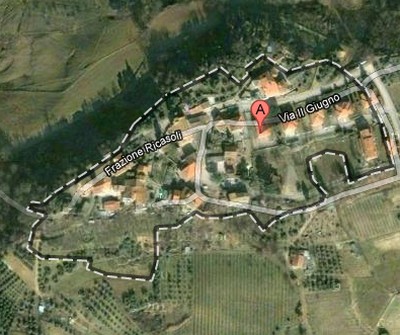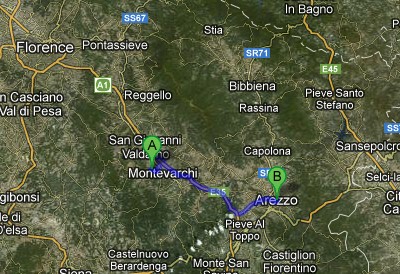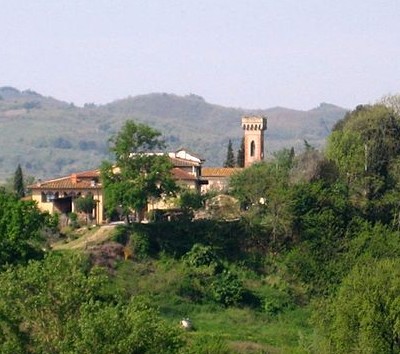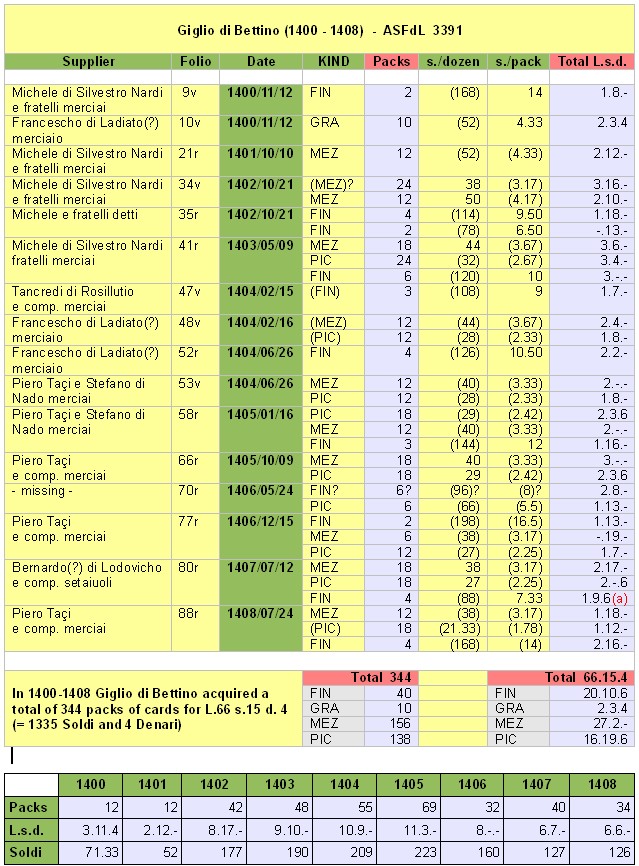Introduction
This note can be considered as an extension of a previous one,(1) and belongs to a research already described. The archive is still the ASFdL in Arezzo,(2) and in the same town was active Giglio di Bettino, the silk-dealer and mercer already encountered. The account book examined here is a different one among those compiled by this trader and still kept in the ASFdL; from its records, new information can be reported here on the trade of playing cards in the first years of the 15th century.
Searching for new information on Giglio di Bettino
This time I felt compelled to search for more information on Giglio di Bettino than I had done in my previous note.(1) I have thus looked for his data in Catasto 1427, where one usually finds basic information, on properties, incomes, composition of the family, and similar useful evidence.
I found him easily in Catasto-Campioni.(3) We only read there his assessment, or taxable income: “Gilio di Bettino setaiuolo, a c. 810, L.295 s.7”; it amounted to a relatively small value, but nevertheless greater than average, especially if one considers that many families had no taxable income at all. As indicated there, more detailed information should have been recorded at fol. 810, supposedly of the Catasto-Portate volumes. Now, there are for Arezzo four such thick registers, numbered from 200 to 203; I could verify all of them, without success.
The book in question should have been No. 203, where unfortunately folios 791 to 810 are missing. I found there the name of Giglio di Bettino in two other places. Fol. 835v: “Aggiunta adì 14 di dicembre 1429. Gilio di Bettino. Messi c. 810”. Fol. 838v: “Adì 18 dottobre [1427?] Arezzo, Gilio di Bettino Setaiolo. Messa a libro c. 810”. In both these additional cases the corresponding information had thus been inserted at the same fol. 810, one of the very few ones that has not been preserved.
More useful has been again the archive of Opera del Duomo of Florence. The appearance there of our Giglio as a fidejussor in 1425 has already been mentioned.(1) Now, I have seen a second and more interesting document there:(4) it is an application of 5 November 1422 by his brother Galeotto, written on his behalf too. The two brothers had been condemned, because they had not paid some debts left by their father Bettino after his death.
Now, Galeotto explained that both brothers were not responsible of their father’s inheritance, because it had been forwarded, according to their father’s will, to a certain Pietro di Simone di Brolio. Therefore, both brothers were ready to take the debts upon themselves only in the case that the legal heir was not found.
We can thus deduce the information that Giglio’s family could not be a wealthy one and that the two brothers had to set up in business for themselves. Moreover, we learn that the family did not come from Arezzo: they were from Ricasoli, a small village 3 km far from Montevarchi. This village still exists, on top of a hillock at 251 meters above sea level; the population of Ricasoli is reported to count 115 inhabitants.(5)
Our Giglio and his books have been inserted into the project, accessible in the web, of a dissertation work,(6) and the author has kindly informed me of the relevant results of this research.(7) In particular, she succeeded in finding the fol. 810 mentioned above, in another Catasto book. I think that the corresponding data will be inserted in her dissertation, and communicated in the next year - let me refer to that source for any further detail. I allow myself to report here just that, at Catasto’s time, Giglio was 55 years old and lived with his wife Giovanna, 40, without any children.
For the moment, we thus remain with little information about Giglio di Bettino; let us be satisfied with the fact that he worked in his shop for a long time; on the other hand, his income of 1427 clearly confirms that he had reached a middle-class position by then.
The account book
After the Naibi pack found in book No. 3390, I was willing to check other books of the same trader. Two of them(8) I could leaf through for a few minutes; they are common “Libri di debitori”, with short entries in which we read the name of the person involved, and the money amount of that particular business; usually, the information on the goods traded is limited, or absent. It is possible that playing cards can be found there, but this would require a more careful examination, which I am deferring to future occasions, if any.
Much more useful has been a smaller book (as often occurs with these registers), which immediately follows that examined earlier in the Inventory, thus after No. 3390 we now have to examine No. 3391.(9)
This account book has been compiled in a way, which is the most suitable for our research. Leafing through it, we see long lists of various goods, commonly occupying a full page, sometimes two of them. These lists concern articles that Giglio had acquired for his shop; apparently, he purchased stocks of goods as provisions for his following sales by retail, and this book was used for registering precisely these purchases. Most of his suppliers were from Florence; certainly from Florence came all his supplies of playing cards.
Unfortunately, this kind of books - with a similar detailed information structured in the most useful way for us - is an exception among all the account books; also the interesting books recently studied in the AOIF were seldom of this kind. It is evident that when the moment arrives to keep only a part of the account books existing in a given archive, those with records of minute trades are the first to get rid of.
In the book under examination we read for example detailed lists of leather wares, from gloves to purses, and handbags: these we can pass over - there are no Naibi in these lists; similarly occurs for tools and hardware, full pages of items of related kinds. Our task is thus simplified here: we have just to check the lists of goods provided by the Florentine mercers; there we sometimes find Naibi, among many other goods, including the more usual clothes and every type of haberdashery.
This particularly useful book presents something unsuitable nevertheless (“la perfezione non è di questo mondo”, is one of our sayings): its folios are unnumbered and for each page I had to figure out which its actual number could be, up to the end of the book, for slightly less than one hundred folios. If anybody verifies the data below in the book – as advisable each time - and does not find the given entry there, I suggest to search it nearby.
Naibi records
The pages with Naibi records that I found are sixteen; all the corresponding entries are summarised in the following Table. (Numbers and attributes within brackets have been derived from other records present in the book.)
All suppliers are indicated as “di Fiorença”, except for Tancredi, noted as “a Fiorença”. In principle, “a” only indicates the place of the store, whereas “di” includes the mercer’s provenance - we may thus suppose that Tancredi worked in Florence but came from another place. In any event, we can neglect this nominal difference, and consider Florence as the real place of origin of all these packs (unless they had arrived into Florence from other towns, another supposedly possible hypothesis, which however is hardly believable at the time).
As for the card kinds, let me refer to a previous note,(10) and to the following discussion.
|

Ricasoli near Montevarchi
between Arezzo and Florence


|
|
The sequence of the trade
It may be useful to discuss what has been found, in the framework of what could be expected. Actually, we could not expect a significant production of playing cards in Arezzo; at most, we could find there a wandering cardmaker, settling for a few months. Therefore, discovering a mercer in Arezzo who about once a year picks up stocks of playing cards in Florence is something that could have been expected, even if no similar information had still been found, to my knowledge.
There could have been alternative ways, however. For instance, Giglio might have purchased his stocks directly from the Florentine cardmakers - this could even imply a lower price of the cards. On the other hand, he could have had just one Florentine mercer as his exclusive supplier of playing cards, whereas we find several of them here, including one silk-dealer.
The evidence found may thus lead to some discussion. When Giglio arrived in Florence to acquire his provisions, playing cards were probably too small a trade to justify a separate purchase. Only a mercer could simultaneously provide him with playing cards and with all the other items acquired together with them.
In a few cases, however, we find that he entered the shop of a second mercer, just for buying there a few additional packs of a different kind. (I thus got the impression that a full stock of playing cards ready to purchase was only present, or at least easier to find, in a store of a mercer and not in the workshop of a cardmaker. This impression however would require to be supported by specific evidence.)
As a result, we regrettably are not able to “see” our Florentine cardmakers at work here; they are only indirectly involved in these trades. Of course, if the Florentine mercers could sell stocks of cards, this means that the local cardmakers currently provided them with a copious supply of packs (or another mercer did, but this guesswork I would better neglect, be it only for the connected price increase).
In this way, we are missing the starting point of the trade, the producer; we only see here the handing over from stage two to stage three. As for stage four, the consumer - or maybe another retailer in a village shop - we also get no information here, apart from the exceptional case of priest Goro in the previous book.(1)
Another missing information is whether Giglio was the sole seller of playing cards in Arezzo – such being the case, one has to be cautious in deducing values for the overall consumption of playing cards in Arezzo and neighbouring territory.
Of course, we are free to reflect on these Naibi packs for better understanding the trade situation in Florence, or in Arezzo, or in both of them. The share of this specific contribution to the total trade at the time was certainly greater for Arezzo than for Florence – but it is a very poor consolation to vaguely see that a numerical rapport may exist between numbers that remain unknown.
In conclusion, what we observe here is only a part of the whole trade path and, in particular, directly involves neither the producer, nor the consumer. This must be kept in mind in order not to infer from these numbers more than is reasonable.
With the limits indicated above, the value of this information is nevertheless very great. We learn in particular that playing cards were by then easily available in Florence, offered on sale as other ordinary goods and tools. They could be acquired at will in the shop of a mercer or even in that of a silk-dealer (as we had perfectly understood from the shop of Lorenzo di Bartolo and Matteo di Zanobi, for later times however).(11)
Naibi kinds
From these records we can observe the market of playing cards at an early stage. Actually, even in the earliest mentioned 1400 year we cannot speak of Naibi as a new playing tool, since their first mention in Florence known to us had been recorded almost a quarter of century before.
However, our knowledge of their production and use remains very unsatisfactory, especially for their initial stages. Due to our insufficient knowledge, even these records appear as a revolutionary piece of news. Nobody could expect, as far as I have learnt, that in these years we already had packs of Naibi easily available on sale, and of the same kinds that we know for later times.
Particularly interesting is the information on their dimension: we already had here all the three typical shapes of the packs, Piccoli, Mezzani, and Grandi. Rather unexpectedly, Mezzani were traded in a somewhat bigger amount than the cheapest Piccoli cards.
The fact that Grandi were only present in a sole trade is not a sure indication that they were correspondingly less produced than the other kinds – this could be a choice by Giglio, who doubted to sell them in Arezzo and adjacent territory.
Moreover, a distinction already existed between ordinary and Fini cards, as we similarly know from later times. Of course, Fini cards were acquired by Giglio in reduced quantities; it could not be a frequent event that of lending them to a priest for 6s.(1) We also learn of two different grades of Fini packs, acquired in the same trade.
Naibi prices
Again, as far as I know, nobody up to now had an idea of Naibi prices at this early (for us) stage. We may be surprised to verify that these prices did not change remarkably in the course of time. This is true not only within the nine years documented here, but also in comparison with the prices that we know from later instances.
These prices form a set of numbers that appears to be consistent and suitable for a trustworthy statistical deduction. We can thus obtain reliable average prices for a dozen ordinary packs: L.30 for Piccoli, L.41 for Mezzani, L.52 for Grandi (in my unorthodox notation, these values roughly correspond to s.2.50, s.3.33, s.4.33, for a single pack, respectively).
A couple of further points must be noted. The last value is that of the only item present, and not a statistical average as the previous ones. In all the individual trades of both the 138 Piccoli and 156 Mezzani packs, the deviations from their average values are relatively small, which adds further confidence in these results.
On the other hand, by averaging over all the 40 Fini packs we find a price slightly lower than 10s. Apart from the record of two different kinds of Fini cards in the same trade, we do not find here a confirmation of two different predominant prices; we rather find a notable dispersion of prices around the average value mentioned, which may point to the presence of various qualities and prices of Fini packs on the market.
The total number of only 40 Fini packs recorded may however be too low for deducing a conclusive result. It is also possible, on the other hand, that the top part of the production is missing here: any Fini packs of a more precious quality, too expensive for being traded by Giglio.
Currency rates in the course of time
We are accustomed to compare prices for trades of different years; this is generally acceptable, especially whenever the time intervals are small. If we compare the prices at time intervals of several decades, however, we are wrong in considering that these money units kept exactly the same value in the course of time.
If we examine the Florentine currency in some detail, we find that people here had various and complex ways for accounting and paying. A basic coin was of course the florin, but there existed several varieties of it, with different values and particularly with different ratios with the L.s.d. system of the account books.
In the 15th century, as in most of the early times, to the Lira of the account books did not correspond any coin. Originally, the Lira was a Libbra, a pound, mass unit, matching the silver amount needed for producing exactly 240 coins of 1d. called “piccioli”: 12d. corresponded to 1s. and 20s. (or 240d.) to 1L. in the account books. Concurrently with this silver basis, the gold florin was introduced in 1252 and for a short period this new coin corresponded to 1L.
The situation changed shortly however and the Lira amounts matching 1 florin increased up to 4 in the end of the 14th century, 6 in the end of the 16th century, and then remained practically constant at 7 for a couple of centuries. From a recent summary by a specialist,(12) we can extract for the years 1400, 1425, 1450 the indicative values of 3.75, 4.00 and 4.25, respectively.
If we plot these ratios as a function of the years, we practically find a straight line. It becomes thus easy to interpolate the “real” prices of the goods traded for any year of the interval, by applying a multiplying coefficient, R, to the prices recorded. If somebody wants to follow this procedure, a simple expression can be employed with sufficient precision: R=4.58-Y/400, where Y is the year in question.
After having multiplied by R any price read in the books, for every year of the interval indicated, all the prices found are valid for the same year, 1425, and we have thus obtained surely comparable values.
Changes in Naibi prices
It is not so convenient, however, to use the procedure indicated above for finding the “real” value of our cards, and of most other goods. I am convinced that directly comparing the prices found in the account books for the years 1400-1450 is already an acceptable approximation. Different may be the case if we extend the limits to previous and following times - the sharpest increases in florin values actually occurred in the last parts of both the 14th and the 15th centuries.
In effect, the difference between the values at the two limits indicated does not even reach 15%. This means that the prices of Giglio’s ordinary Naibi packs could, at most, be assessed in 1450 at 3s., 4s., and 5s. for Piccoli, Mezzani and Grandi, respectively.
There are further reasons supporting more constant values of the goods traded than expected from currency changes. For instance, whenever a buyer paid his purchases in kind, with his own products, this could be largely indifferent to simultaneous changes in the money values. On the other hand, it may even be wrong to merely follow the currency changes: for some goods, “real” values increasing with time have been reported,(13) contrary to the general behaviour.
A rather similar indication comes from another sector: the same source(12) indicates for all the time from 1350 to 1525 precisely the same day wage of 10s. for a manual worker. (This clearly matches the known fact that the labour class run by then into an increasing poverty.)
After having suggested that the prices of playing cards of the same kind remained almost constant in the course of time, we may better isolate and discuss actual cases in which the prices recorded were really different. It is possible to mention several cases in which the prices recorded in the following years were remarkably different from the “rule”, both for cheaper and for more expensive packs. In my opinion, these cases of outstanding price changes should be explained with different qualities of the playing cards involved.
In particular, I have in mind the Naibi Piccoli made by Nicolò di Calvello in the late 1440s.(14) Their price, around 1s. for a pack, was less than one half of the expected one. As mentioned above, I suppose that the discrepancy was not due to reduced prices of the same cards, but instead to the introduction of a cheaper process for their production, and immediately some new printing or painting methods come to the mind.
Conclusions
Once or twice in a year, Giglio di Bettino acquired supplies of Naibi in Florence, to be sold during the following months in his shop in Arezzo. From their records, we obtain previously unknown detail on kinds and prices of playing cards traded at the time. The new information obtained is rich, surprisingly rich for the period, involving more than three hundred card packs of just beginning 15th century.
Most of the rare information that has reached us from these early ages came up to now from royal courts, simply because it is mostly from these milieus that handwritten documents have been saved. Naibi represented however a more widespread game medium, available to common people, and this report is just a further confirmation: we find here, in the shop of a retailer, more card packs than in dozens of royal courts of the time, as it was reasonable to expect.
In front of the account book discussed here, my conclusion is that the main difficulty in searching in a book of this kind is not to discover a needle in a hay-stack, as experts told me at the beginning of this research, but first to discover instead the atypical hay-stack, where needles do exist.
Footnotes:
(1) Franco Pratesi: 1400 - Naibi on Loan in Arezzo, 01.11.2012
(2) Fraternita dei Laici
(3) ASF, Catasto 273. fol. 25v.
(4) DOCUMENT: o0201081.027c ; DATE: 1422 novembre 5 ; TITLE: Galeotti de Ricasoli
(5) Information to Ricasoli
(6) Ilaria Becattini: Arezzo nel primo Quattrocento: attività economiche e struttura sociale
(7) Ilaria Becattini, Personal communication, 21.11.2012.
(8) ASFdL 3385, ASFdL 3388.
(9) ASFdL 3391, “Memoriale”.
(10) Franco Pratesi: Naibi with Attributes, 25.02.2012
(11) Franco Pratesi: Naibi sold by Silk-Dealers, 03.03.2012
(12) Richard A. Goldthwaite, The economy of Renaissance Florence. Baltimore 2009. Preview at books.google.com
(13) Sergio Tognetti, Un’industria di lusso al servizio del grande commercio. Firenze 2002. Snippet view at books.google.com
(14) Franco Pratesi: 1431-1460: Naibi acquired by Silk-Dealers, 20.04.2012
|
|




